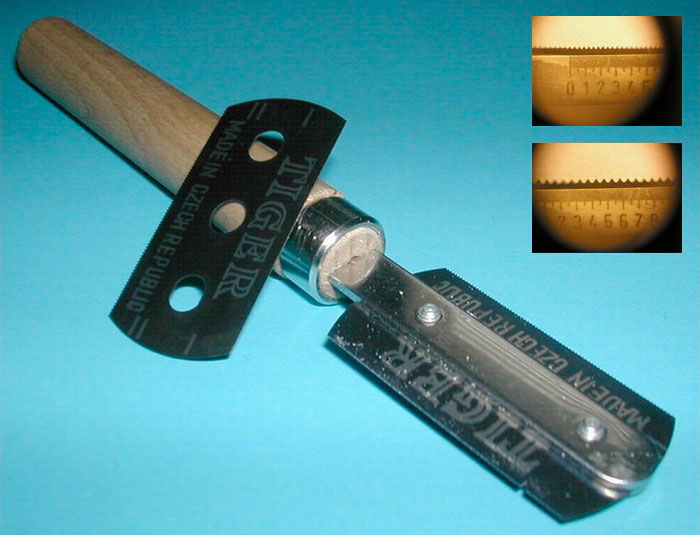I have made reference to this saw in a number of posting, as I have been using the basic saw for a couple of years. But it seems some thought that a more formal review of the saw, including its Anniversary edition, is warranted.
For a tool that appears so simple, it is finely designed and well made. The basic concept of the saw it to take metal the size of and as thin as a double edged razor blade and put teeth along the edges. On one edge is the “fine” edge and on the other is the “even finer” edge. How they get the teeth cut so finely appears to be a secret, and it amazes me that they can do it.
But the terms “fine” and “finer” are relative. The fine edge is finer than any hobby saw I have used. Only a jeweler’s saw would provide such a fine cut, but probably with less control. And the “finer” edge is, well, even finer. When using the saw you need to hold it up to a bright light or carefully run your fingers along the edges to determine which is the fine or finer of the two edges.

As for the difference between the Basic and Anniversary editions, there is no difference in the basic saw. The handle and the saw blade are the same. The Anniversary edition, however, does provide some additional features that some modelers may find helpful.
The most obvious difference is the inclusion of the JLC extender set in the Anniversary edition. This is a set of five spacers: one each .25mm, .5mm,1.5mm and two 1mm. There are also the extended screws for mounting the spacers. These spacers allow the modeler to make parallel cuts without having to measure and re-measure. If you need to take 2.5mm out of two gear legs, then use the 1.5mm and 1mm spacer and make one cut in each leg, not two. It keeps the spacing of the cut constant.
The Anniversary edition also includes one extra blade (total of three blades, as opposed to two in the Basic boxing) and a padded plastic case in which to store the saw, blades and spacers.
But there are some limitations to the JLC saw. The first is the depth of the cut, which is limited to approximately ¼ inch or 6.5mm. As I use this saw primarily to cut open injection molded 1/48 canopies, I do find I may have to make more than one cut or move the saw about, rather than cutting straight down through. Of course to make a deeper single cut, one could always hold the bare blade in one’s hand, but with great care.
That being said, the JLC saw allowed me to cut apart, smoothly, cleanly and evenly, such canopies as the Classic Airframes Sea Hawk and the Special Hobby Fiat G.55. Most razor saws would be too thick and a jeweler’s saw would flex too much.
The second limitation is the brittle nature of the blades; they will snap if flexed too much. But a broken blade does not mean you toss it into the dustbin, feeling that you’ve just wasted your money. UMM-USA has come up with an excellent recycling suggestion to allow one to get a lot more use out of a broken blade. You can see the suggestion by clicking on this link. I have also put the broken piece in the jaws of a surgical Kelly clamp.
All things considered, I’m not sure what more I can say other than what I have been saying for quite some time: If you need to make an ultra fine cut, such as cutting apart a canopy, then there is nothing better than the JLC saw from UMM-USA. By the way, it is also great for cutting resin pieces. Using the JLC saw is usually much better and easier than cutting a fine piece of resin using a #11 blade.
To paraphrase American Express; “Don’t model without it”.
Replacement blades are available from UMM-US in packs of three and packs of five blades.
Thanks to John Vojtech of UMM-USA for the Anniversary Pack review sample.
